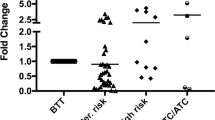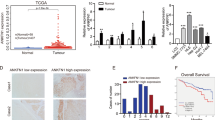Abstract
Thyroid hormone, 3, 3′, 5-triiodo-L-thyronine (T3), mediates cell growth, development and differentiation by binding to its nuclear receptors (TRs). The role of TRs in cancer is still undefined. Notably, hyperthyroxinemia has been reported to influence the rate of colon cancer in an experimental model of carcinogenesis in rats. Previous microarray analysis revealed that cathepsin H (CTSH) is upregulated by T3 in HepG2-TR cells. We verified that mRNA and protein expression of CTSH are induced by T3 in HepG2-TR cells and in thyroidectomized rats following administration of T3. The possible thyroid hormone-responsive elements of the CTSH promoter localized to the nucleotides –2038 to –1966 and –1565 to –1501 regions. An in vitro functional assay showed that CTSH can increase metastasis. J7 cells overexpressing CTSH were inoculated into severe combined immune-deficient mice and these J7-CTSH mice displayed a greater metastatic potential than did J7-control mice. The clinicopathologic significance of CTSH expression in hepatocellular carcinoma (HCC) was also investigated. The CTSH overexpressing in HCC was associated with the presence of microvascular invasion (P=0.037). The microvascular invasion characteristic is closely related to our in vitro characterization of CTSH function. Our results show that T3-mediated upregulation of CTSH led to matrix metallopeptidase or extracellular signal-regulated kinase activation and increased cell migration. This study demonstrated that CTSH overexpression in a subset hepatoma may be TR dependent and suggests that this overexpression has an important role in hepatoma progression.
This is a preview of subscription content, access via your institution
Access options
Subscribe to this journal
Receive 50 print issues and online access
$259.00 per year
only $5.18 per issue
Buy this article
- Purchase on Springer Link
- Instant access to full article PDF
Prices may be subject to local taxes which are calculated during checkout






Similar content being viewed by others
References
Ando S, Sarlis NJ, Krishnan J, Feng X, Refetoff S, Zhang MQ et al. (2001). Aberrant alternative splicing of thyroid hormone receptor in a TSH-secreting pituitary tumor is a mechanism for hormone resistance. Mol Endocrinol 15: 1529–1538.
Barrera-Hernandez G, Park KS, Dace A, Zhan Q, Cheng SY . (1999). Thyroid hormone-induced cell proliferation in GC cells is mediated by changes in G1 cyclin/cyclin-dependent kinase levels and activity. Endocrinology 140: 5267–5274.
Berdowska I . (2004). Cysteine proteases as disease markers. Clin Chim Acta 342: 41–69.
Chamba A, Neuberger J, Strain A, Hopkins J, Sheppard MC, Franklyn JA . (1996). Expression and function of thyroid hormone receptor variants in normal and chronically diseased human liver. J Clin Endocrinol Metab 81: 360–367.
Chen RN, Huang YH, Lin YC, Yeh CT, Liang Y, Chen SL et al. (2008a). Thyroid hormone promotes cell invasion through activation of furin expression in human hepatoma cell lines. Endocrinology 149: 3817–3831.
Chen RN, Huang YH, Yeh CT, Liao CH, Lin KH . (2008b). Thyroid hormone receptors suppress pituitary tumor transforming gene 1 activity in hepatoma. Cancer Res 68: 1697–1706.
Chiloeches A, Sanchez-Pacheco A, Gil-Araujo B, Aranda A, Lasa M . (2008). Thyroid hormone-mediated activation of the ERK/dual specificity phosphatase 1 pathway augments the apoptosis of GH4C1 cells by down-regulating nuclear factor-kappaB activity. Mol Endocrinol 22: 2466–2480.
Davis FB, Tang HY, Shih A, Keating T, Lansing L, Hercbergs A et al. (2006). Acting via a cell surface receptor, thyroid hormone is a growth factor for glioma cells. Cancer Res 66: 7270–7275.
del Re EC, Shuja S, Cai J, Murnane MJ . (2000). Alterations in cathepsin H activity and protein patterns in human colorectal carcinomas. Br J Cancer 82: 1317–1326.
Dickinson DP . (2002). Cysteine peptidases of mammals: their biological roles and potential effects in the oral cavity and other tissues in health and disease. Crit Rev Oral Biol Med 13: 238–275.
Gabrijelcic D, Svetic B, Spaic D, Skrk J, Budihna M, Dolenc I et al. (1992). Cathepsins B, H and L in human breast carcinoma. Eur J Clin Chem Clin Biochem 30: 69–74.
Gocheva V, Joyce JA . (2007). Cysteine cathepsins and the cutting edge of cancer invasion. Cell Cycle 6: 60–64.
Hall LC, Salazar EP, Kane SR, Liu N . (2008). Effects of thyroid hormones on human breast cancer cell proliferation. J Steroid Biochem Mol Biol 109: 57–66.
Hassan MM, Kaseb A, Li D, Patt YZ, Vauthey JN, Thomas MB et al. (2009). Association between hypothyroidism and hepatocellular carcinoma: a case-control study in the United States. Hepatology 49: 1563–1570.
Huang C, Jacobson K, Schaller MD . (2004). MAP kinases and cell migration. J Cell Sci 117: 4619–4628.
Huang YH, Lee CY, Tai PJ, Yen CC, Liao CY, Chen WJ et al. (2006). Indirect regulation of human dehydroepiandrosterone sulfotransferase family 1A member 2 by thyroid hormones. Endocrinology 147: 2481–2489.
Huang YH, Liao CH, Chen RN, Liao CJ, Lin KH . (2010). Human testicular orphan receptor 4 enhances thyroid hormone receptor signaling. J Cell Physiol 222: 347–356.
Huang YH, Tsai MM, Lin KH . (2008). Thyroid hormone dependent regulation of target genes and their physiological significance. Chang Gung Med J 31: 325–334.
Joyce JA, Hanahan D . (2004). Multiple roles for cysteine cathepsins in cancer. Cell Cycle 3: 1516–1619.
Kos J, Stabuc B, Schweiger A, Krasovec M, Cimerman N, Kopitar-Jerala N et al. (1997). Cathepsins B, H, and L and their inhibitors stefin A and cystatin C in sera of melanoma patients. Clin Cancer Res 3: 1815–1822.
Kress E, Rezza A, Nadjar J, Samarut J, Plateroti M . (2009). The frizzled-related sFRP2 gene is a target of thyroid hormone receptor alpha1 and activates beta-catenin signaling in mouse intestine. J Biol Chem 284: 1234–1241.
Kress E, Skah S, Sirakov M, Nadjar J, Gadot N, Scoazec JY et al. (2010). Cooperation between the thyroid hormone receptor TRalpha1 and the WNT pathway in the induction of intestinal tumorigenesis. Gastroenterology 138: 1863–1874.
Lazar MA . (1993). Thyroid hormone receptors: multiple forms, multiple possibilities. Endocr Rev 14: 184–193.
Liao CH, Yeh SC, Huang YH, Chen RN, Tsai MM, Chen WJ et al. (2010). Positive regulation of spondin 2 by thyroid hormone is associated with cell migration and invasion. Endocr Relat Cancer 17: 99–111.
Liao CS, Tai PJ, Huang YH, Chen RN, Wu SM, Kuo LW et al. (2009). Regulation of AKR1B1 by thyroid hormone and its receptors. Mol Cell Endocrinol 307: 109–117.
Lin KH, Shieh HY, Hsu HC . (2000). Negative regulation of the antimetastatic gene Nm23-H1 by thyroid hormone receptors. Endocrinology 141: 2540–2547.
Lin KH, Wu YH, Chen SL . (2001). Impaired interaction of mutant thyroid hormone receptors associated with human hepatocellular carcinoma with transcriptional coregulators. Endocrinology 142: 653–662.
Martinez-Iglesias O, Garcia-Silva S, Regadera J, Aranda A . (2009). Hypothyroidism enhances tumor invasiveness and metastasis development. PLoS One 4: e6428.
Mohamed MM, Sloane BF . (2006). Cysteine cathepsins: multifunctional enzymes in cancer. Nat Rev Cancer 6: 764–775.
Nelson D, Ganss R . (2006). Tumor growth or regression: powered by inflammation. J Leukoc Biol 80: 685–690.
Palermo C, Joyce JA . (2008). Cysteine cathepsin proteases as pharmacological targets in cancer. Trends Pharmacol Sci 29: 22–28.
Plateroti M, Kress E, Mori JI, Samarut J . (2006). Thyroid hormone receptor alpha1 directly controls transcription of the beta-catenin gene in intestinal epithelial cells. Mol Cell Biol 26: 3204–3214.
Puzianowska-Kuznicka M, Krystyniak A, Madej A, Cheng SY, Nauman J . (2002). Functionally impaired TR mutants are present in thyroid papillary cancer. J Clin Endocrinol Metab 87: 1120–1128.
Rosen MD, Privalsky ML . (2009). Thyroid hormone receptor mutations found in renal clear cell carcinomas alter corepressor release and reveal helix 12 as key determinant of corepressor specificity. Mol Endocrinol 23: 1183–1192.
Samuels HH, Stanley F, Casanova J . (1979). Depletion of L-3,5,3′-triiodothyronine and L-thyroxine in euthyroid calf serum for use in cell culture studies of the action of thyroid hormone. Endocrinology 105: 80–85.
Schraufstatter IU, Trieu K, Zhao M, Rose DM, Terkeltaub RA, Burger M . (2003). IL-8-mediated cell migration in endothelial cells depends on cathepsin B activity and transactivation of the epidermal growth factor receptor. J Immunol 171: 6714–6722.
Shih CH, Chen SL, Yen CC, Huang YH, Chen CD, Lee YS et al. (2004). Thyroid hormone receptor-dependent transcriptional regulation of fibrinogen and coagulation proteins. Endocrinology 145: 2804–2814.
Sivaparvathi M, Sawaya R, Gokaslan ZL, Chintala SK, Rao JS . (1996). Expression and the role of cathepsin H in human glioma progression and invasion. Cancer Lett 104: 121–126.
Suzuki H, Willingham MC, Cheng SY . (2002). Mice with a mutation in the thyroid hormone receptor beta gene spontaneously develop thyroid carcinoma: a mouse model of thyroid carcinogenesis. Thyroid 12: 963–969.
Teranishi S, Kimura K, Nishida T . (2009). Role of formation of an ERK-FAK-paxillin complex in migration of human corneal epithelial cells during wound closure in vitro. Invest Ophthalmol Vis Sci 50: 5646–5652.
Thormeyer D, Baniahmad A . (1999). The v-erbA oncogene (review). Int J Mol Med 4: 351–358.
Tsui KH, Hsieh WC, Lin MH, Chang PL, Juang HH . (2008). Triiodothyronine modulates cell proliferation of human prostatic carcinoma cells by downregulation of the B-cell translocation gene 2. Prostate 68: 610–619.
Tsushima H, Ueki A, Matsuoka Y, Mihara H, Hopsu-Havu VK . (1991). Characterization of a cathepsin-H-like enzyme from a human melanoma cell line. Int J Cancer 48: 726–732.
Turk B, Turk D, Turk V . (2000). Lysosomal cysteine proteases: more than scavengers. Biochim Biophys Acta 1477: 98–111.
Turk V, Turk B, Turk D . (2001). Lysosomal cysteine proteases: facts and opportunities. EMBO J 20: 4629–4633.
Wilson TJ, Singh RK . (2008). Proteases as modulators of tumor-stromal interaction: primary tumors to bone metastases. Biochim Biophys Acta 1785: 85–95.
Wu SM, Huang YH, Lu YH, Chien LF, Yeh CT, Tsai MM et al. (2010). Thyroid hormone receptor-mediated regulation of the methionine adenosyltransferase 1 gene is associated with cell invasion in hepatoma cell lines. Cell Mol Life Sci 67: 1831–1843.
Yang H, Yuan P, Wu V, Tache Y . (1999). Feedback regulation of thyrotropin-releasing hormone gene expression by thyroid hormone in the caudal raphe nuclei in rats. Endocrinology 140: 43–49.
Yang L, Moses HL . (2008). Transforming growth factor beta: tumor suppressor or promoter? Are host immune cells the answer? Cancer Res 68: 9107–9111.
Yen PM . (2001). Physiological and molecular basis of thyroid hormone action. Physiol Rev 81: 1097–1142.
Yen PM, Ikeda M, Brubaker JH, Forgione M, Sugawara A, Chin WW . (1994). Roles of v-erbA homodimers and heterodimers in mediating dominant negative activity by v-erbA. J Biol Chem 269: 903–909.
Zhu XG, Zhao L, Willingham MC, Cheng SY . (2010). Thyroid hormone receptors are tumor suppressors in a mouse model of metastatic follicular thyroid carcinoma. Oncogene 29: 1909–1919.
Acknowledgements
This work was supported by grants from Chang-Gung University, Taoyuan, Taiwan (CMRPD 34013, NMRP 140511) and from the National Science Council of the Republic of China (NSC 94-2320-B-182-052).
Author information
Authors and Affiliations
Corresponding author
Ethics declarations
Competing interests
The authors declare no conflict of interest.
Additional information
Supplementary Information accompanies the paper on the Oncogene website
Rights and permissions
About this article
Cite this article
Wu, SM., Huang, YH., Yeh, CT. et al. Cathepsin H regulated by the thyroid hormone receptors associate with tumor invasion in human hepatoma cells. Oncogene 30, 2057–2069 (2011). https://doi.org/10.1038/onc.2010.585
Received:
Revised:
Accepted:
Published:
Issue Date:
DOI: https://doi.org/10.1038/onc.2010.585
Keywords
This article is cited by
-
Microvascular Venous Invasion in Hepatocellular Carcinoma: Why Do Recurrences Occur?
Journal of Gastrointestinal Cancer (2020)
-
A parallel and quantitative cell migration assay using a novel multi-well-based device
Biomedical Microdevices (2016)
-
Glucose-regulated protein 58 modulates β-catenin protein stability in a cervical adenocarcinoma cell line
BMC Cancer (2014)
-
Thyroid hormones and their nuclear receptors: new players in intestinal epithelium stem cell biology?
Cellular and Molecular Life Sciences (2014)
-
Thyroid hormone receptor represses miR-17 expression to enhance tumor metastasis in human hepatoma cells
Oncogene (2013)



